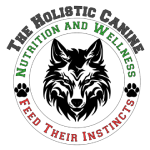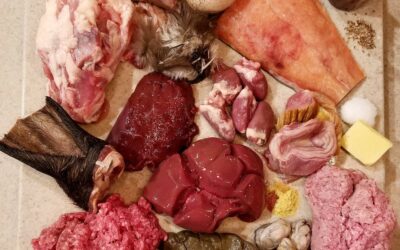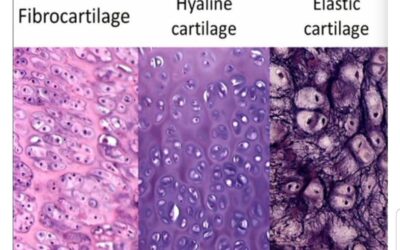Excerpt Lessons from our Raw Feeding Course
To take advantage of the full course available for FREE, please join The Holistic Canine: Raw Feeding, Naturopathy, & Keto group on Facebook!
What does my dog require? Lesson II
Your dog has several requirements that are necessary for health, health maintenance, healing, and disease prevention. If you are feeding a puppy, his or her needs are even greater and more important for proper growth and development. These are critical requirements that need your special attention.
First and foremost your dog requires food for energy. Energy is primary. Without energy there is no function, without function life ceases. So food must first provide energy. Secondly, food contains vital nutrients that your dog requires for physiological and cellular function. Your dog’s digestive system is perfectly able to release nutrients from species-appropriate foods by mechanically and chemically breaking it down into its smallest components. Once these components are released, the nutrients are then absorbed into the bloodstream via the intestinal wall where they are carried and distributed throughout the body as and where needed. Others that are in abundance are either stored in tissues or later excreted.
Your dog requires:
- Protein
- Fats
- Vitamins
- Minerals
Protein and fats both supply calories and therefore potential energy (calories). Fat should be your dog’s main fuel source with protein as secondary.
Keep in mind: These above nutrients are the known and studied essential nutrients. There are many more nutrients that science has not yet studied fully or even discovered. This is why feeding species-appropriate foods is so vital for making sure your dog is receiving an abundance of nutrients, both the known, the new and indefinite, and the yet-to-be-discovered.
Protein is needed for:
- building, repairing, and maintaining tissues such as muscles, bones, organs, blood, cartilage, skin, and nails
- the building, repair, and maintenance of cells
- the production of enzymes
- the production of hormones
- the production of antibodies
- the production of signaling proteins
- the production of bodily chemicals
- immune function
- energy
Fat is needed for:
- energy
- the structural components of cells and cell wall integrity
- carrying fat-soluble vitamins for absorption
- physiological processes such as blood clotting, inflammatory response, and tissue healing
- hormone production
- brain function
- immune function
Vitamins and minerals are needed by every cell, tissue, organ, and muscle and for every physiological function of the body. They are required for hundreds of functions and roles throughout your dog’s body.
SPECIES-APPROPRIATE FOOD SOURCES:
Protein → meat, poultry, fish, organs, eggs, milk products
Fats → meat, poultry with skin, oily fish, organs, egg yolks, bone marrow, milk products, oils
Vitamins & minerals → bones, meat, poultry, fish, organs, eggs, milk products, whole-foods supplements and powders
SPECIES-INAPPROPRIATE FOOD SOURCES that may provide benefit:
Fats → avocado, ground seeds
Vitamins & minerals → pureed vegetables, fruit, ground seeds
©2019 Kimberly Lloyd, PhD, BCHHP, Cert Raw Dog Food Nutritionist
My dog needs how many nutrients?! HELP! Lesson IV
You have already learned that your dog not only requires energy from food, but also protein, fats, vitamins, and minerals. Proteins and fats are pretty simple to source with the added bonus of also being the main energy providers. Meat and organs deliver ample amounts of amino acids, fats, and calories making providing these nutritional necessities a simple task. Now here comes the worrisome part.
What about all those vitamins and minerals?
This is where DIY raw feeding gets scary and many pet parents rightfully get uncomfortable. I want to assure you, it is not all that difficult once you learn the basics.
Let’s start with the easy part. The NRC has compiled their research into a library of books for animal health and nutrition. One such book is the “Nutrient Requirements of Dogs and Cats.” In this work is a list of the known vitamins and minerals (micronutrients) required in the diet of dogs along with their recommended daily amounts. The following is the list of vitamins and minerals recommended daily by the NRC:
- Vitamin A
- Vitamin B1
- Vitamin B2
- Vitamin B3
- Pantothenic acid
- Vitamin B6
- Folate
- Vitamin B12
- Choline
- Vitamin D
- Vitamin E
- Vitamin K
- Calcium
- Phosphorous
- Magnesium
- Potassium
- Sodium
- Chloride
- Iron
- Copper
- Zinc
- Manganese
- Iodine
- Selenium
The question that we must now ask is HOW MUCH of each nutrient needs to be provided. So, how much of each individual micronutrient does your dog need in daily meals? Before I answer that, take a look at the following list. This will give you an idea of the daily recommended requirements per 1,000 kcal in accordance with the NRC, AAFCO, FEDIAF, and my own research.
| Vitamin A Vitamin B1 Vitamin B2 Vitamin B3 Pantothenic acid Vitamin B6 Folate Vitamin B12 Choline Vitamin D Vitamin E Vitamin K Calcium Phosphorous Magnesium Potassium Sodium Chloride Iron Copper Zinc Manganese Iodine Selenium | 380 RE to 16,000 RE 0.56 mg 1.4 mg 4.25 mg 4 mg 0.4 mg 68 mcg 8.75 mcg 425 mg 3.4 mcg to 20 mcg 7.5 mg 410 mcg 1,200 mg 1,000 mg 190 mg 1,250 mg 250 mg 400 mg 9 mg 1.8 mg 20 mg 1.5 mg 220 mcg 90 mcg |
Looks daunting, doesn’t it? The single greatest concern I hear from pet parents is their fear that they are not or will not be able to provide all of these nutrients. And yes, it is a sensible fear. After all, your dog’s health is relying on your knowledge, efforts, and meal prep skills.
Can you just wing it? You want my honest answer? My answer is this…of course not! So now what?
Let’s start with the easy part. Of all those nutrients listed above, most of them are really quite easy to get into the diet daily. Here are the easy nutrients:
- Vitamin A
- Vitamin B1, B2, B3, B5, B6, B12, folate
- Calcium
- Phosphorous
- Potassium
- Sodium
- Chloride
- Selenium
The following are not too difficult, but do take a little know-how:
- Choline
- Vitamin D
- Vitamin K
- Magnesium
- Iron
- Copper
And finally, the difficult nutrients:
- Vitamin E
- Zinc
- Manganese
- Iodine
Does it still look difficult now? It shouldn’t! You just have to focus on a few nutrients and have the confidence that the remainder of the essential nutrients are being provided with a properly planned and balanced diet. This is best done by rotating ingredients and providing several meat, organ, and bone options. Variety and rotation is the key.
Let’s go back to the HOW to be sure your dog is receiving all they require. For starters, the easy-to-source nutrients will almost always be in meals provided you are feeding at least:
- two skeletal proteins per meal
- at least one internal muscle organ such as heart
- you have included liver
- you have one other secreting organ
And… - a minimum of 10%, preferably 12%, bone. You can even go as high as 15% bone per day.
How easy is that?! Now let’s move on to the more challenging nutrients.
- Choline
- Vitamin D
- Vitamin K
- Magnesium
- Iron
- Copper
Choline is richest in eggs. If you are feeding eggs, you have met choline needs. And if you are providing free-range eggs, you are also providing a source of vitamin D and possibly even vitamin E if the chickens are fed flaxseeds. On top of that, eggs are rich in B vitamins, calcium, selenium, iron, and zinc. Duck, quail, and even turkey eggs also provide a wealth of nutrients and benefits.
Vitamin D, besides egg yolks, is also found in fatty fish such as sardines, mackerel, and salmon. Only a small amount of fish is needed in meals. You get the benefit of vitamin D and omega-3 fatty acids among a wealth of other nutrients.
Vitamin K may seem tricky especially if you’re using a nutrient auditing program or spreadsheet and are not feeding vegetables, but I have news for you. There are two forms of vitamin K and dogs only require one of them. Dogs need vitamin K2 known as menaquinone. Vitamin K1 is phylloquinone, a plant form of vitamin K. In humans, the absorption rate of K1 is less than 10%. What do you think absorption rate is in dogs who have a different digestive tract from humans? You guessed it…next to none! Your dog does not need vitamin K1 which they cannot absorb. The highest sources of K2 are found in goose liver, milk products, egg yolks, and beef. Of course other meats and organs contain K2, so don’t be concerned if you are feeding in rotation.
Magnesium is really not all that difficult. It may look difficult on auditing programs due to the programs’ lack of account for bone minerals. Magnesium is found in a good amount in bones. In fact, 60% of body magnesium is stored in bones. That’s a lot of magnesium in bones! If you are feeding an ample bone percentage, your dog is getting a wealth of bioavailable magnesium along with other nutrients. Magnesium is also found in impressive amounts in salmon, mackerel, and halibut (even tuna, but I don’t recommend feeding tuna due to its mercury content). And if you’re feeling brave standing up to the myths circulating within the dog community, avocados are an excellent source of magnesium and a whole host of other nutrients. And guess what? Avocado flesh is NOT toxic to dogs. Don’t be shy, add a small amount to meals!
Iron is also quite easy to source if you are regularly feeding red meats, organs, and adding myoglobin. Myoglobin is the red juice drippings from meat and organs that many people mistake for blood. It is a very rich source of iron and amino acids. And guess where else iron is found? BONES!
Copper is actually TOO easy to source and that can be a problem because too much is NOT a good thing. If you are feeding beef/calf liver and/or lamb liver, be careful not to feed too much. Copper can cause toxicity and zinc deficiency. BUT, if you’re not feeding beef or lamb liver, your copper will be too low. So be sure to feed beef, calf, and/or lamb liver as a regular part of meals in just the right amount for your dog’s needs.
Do you see the common denominators in the above? They are:
- Eggs
- Fish
- Bones
- Liver
You should already be adding these to your dog’s diet anyway. Let’s move on to the hardest to source nutrients which you are about to find out are just as simple as all the rest.
- Vitamin E
- Zinc
- Manganese
- Iodine
Vitamin E is rich in flax-fed free-range egg yolks. It is even found in the bone marrow of mammals. Yet, is it enough to meet requirements? What if I told you that selenium does the job of vitamin E? If you are feeding ample amounts of selenium (which is not at all hard to do) then vitamin E is not essential. It is just an extra bonus in meals. Many pet parents purchase a natural vitamin E oil supplement and add a few drops of oil to meals. Easy peasy!
Zinc is also not difficult. In fact, zinc is quite easy to source. Bone is an excellent source of zinc as are oysters. Oysters are extremely high in zinc, so much so that you need only add small amounts to meals. And the best part is you can buy them just about anywhere in the canned fish aisle. (Psst…Walmart!)
Manganese is actually a tough one if you are not feeding large amount of RMBs with connective tissues. Manganese is rich in joint tissue, ligaments, cartilage, trachea, and bone marrow. It is also found in green tripe. These ingredients are not always feasible, so another rich source is mussels. If you can source mussels, you have your manganese requirement met well over what your dog requires.
Iodine is also not difficult. Nearly all foods contain trace amounts of iodine. Iodine is found in free-range eggs and dairy products. The easiest source of iodine is the seaweed kelp. But because kelp is so high in iodine, you must take great caution to be sure you only ever use a supplement that is analyzed for iodine levels. NEVER exceed the recommended dose for your dog. And if you have a large breed, do NOT exceed 300 mcg.To discover how much of each nutrient your dog needs, use the information in the previous lesson to determine your dog’s estimated calorie requirements per day.
To discover how much of each nutrient your dog needs, use the information in the previous lesson to determine your dog’s estimated calorie requirements per day.
If your dog needs more than 1,000 calories, multiply the NRC (et all) recommended nutrient amounts listed above by your dog’s calorie need. This is how is it done.
- Magnesium requirement per 1,000 kcal = 190 mg
- If your dog requires 1,575 calories per day, you will multiply by 1.575.
- 190 mg x 1.575 = 299.25 mg magnesium / day
If your dog requires less than 1,000 calories per day, also multiply in the same manner.
- Folate requirement per 1,000 kcal = 68 mcg
- If your dog requires 430 calories per day, you will multiply by 0.43.
- 68 mcg x 0.43 = 29.24 mcg folate / day
Do the exact same math for every nutrient and you will have all of your dog’s daily requirements. Make sure you keep them in a safe spot to save you from doing the math all over again!
©2019 Kimberly Lloyd, PhD, BCHHP, Cert Raw Dog Food Nutritionist
These lessons are the property of The Holistic Canine. ©2019 Copyright; use only with permission.



